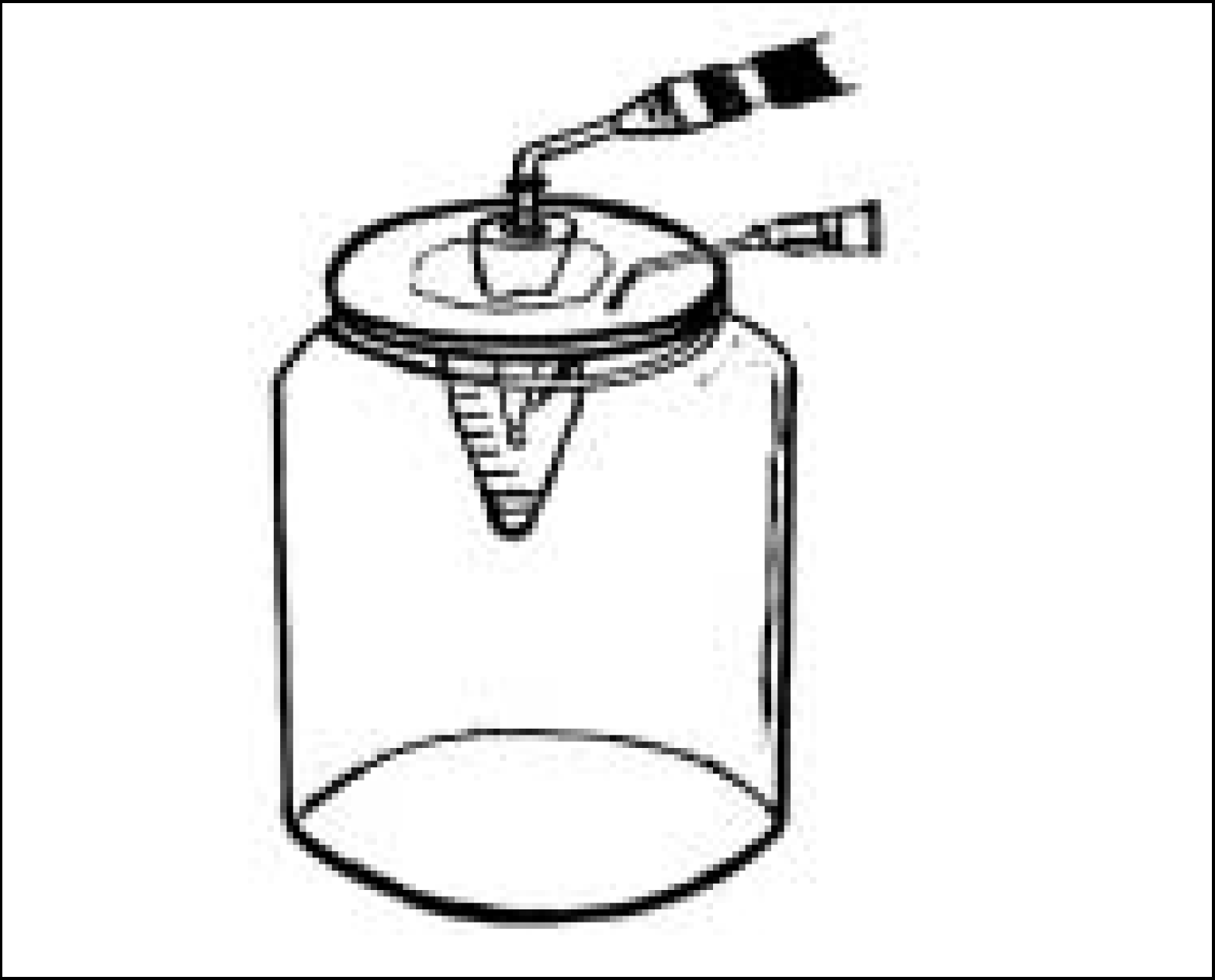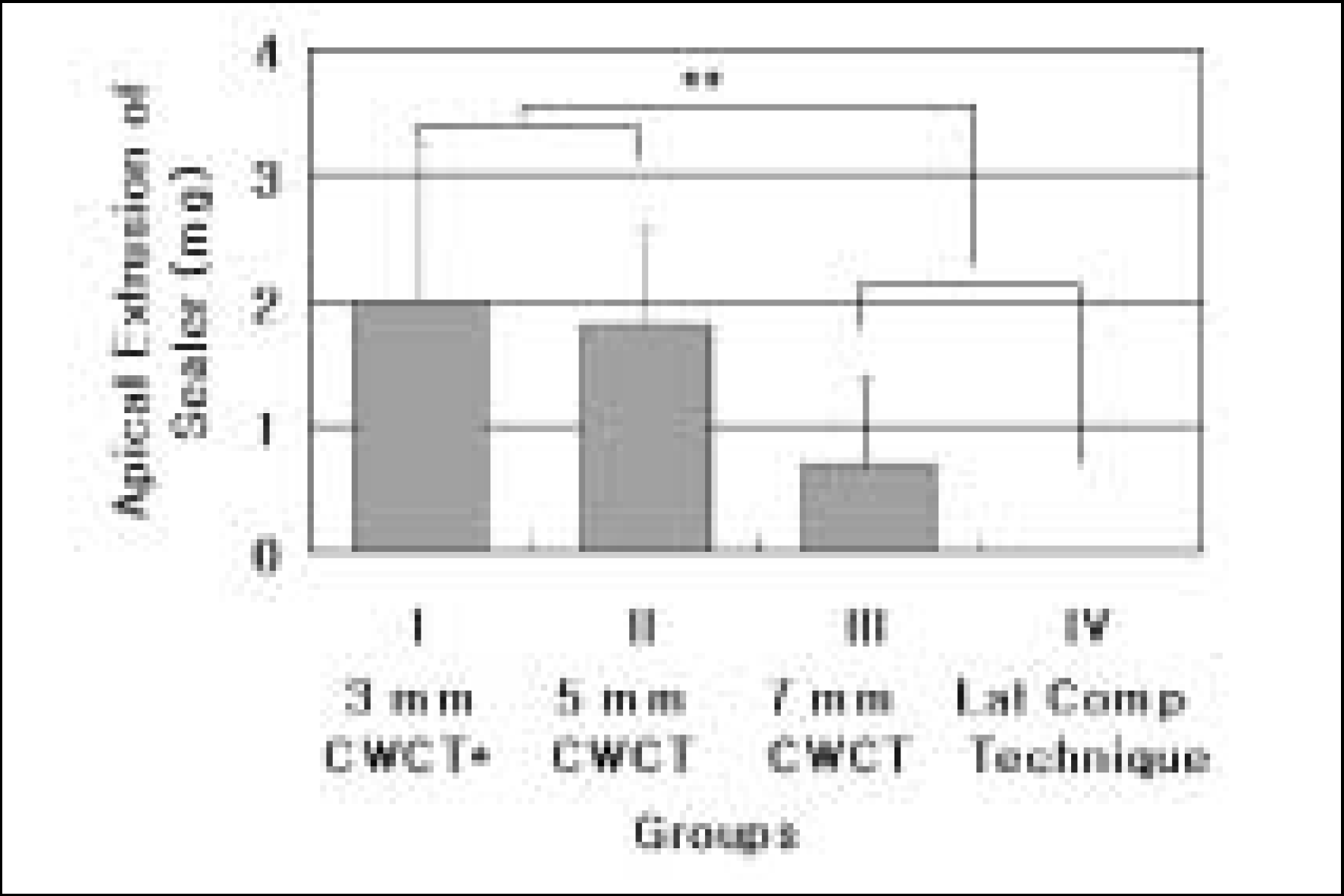ABSTRACT
The purpose of this study was to evaluate the influence of plugger penetration depth on the apical extrusion of root canal sealer during root canal obturation with Continuous Wave of Condensation Technique.
Root canals of forty extracted human teeth were divided into four groups and were prepared up to size 40 of 0.06 taper with ProFile. After drying, canals of three groups were filled with Continuous Wave of Condensation Technique with System B™ and different plugger penetration depths of 3, 5, and 7 mm from the apex. Canals of one group were filled with cold lateral compaction technique as a control. Canals were filled with non-standardized master gutta-percha cones and 0.02 mL of Sealapex. Apical extruded sealer was collected in a container and weighed. Data was analyzed with one-way ANOVA and Duncan’s Multiple Range Test. 3 and 5 mm penetration depth groups in Continuous Wave of Condensation Technique showed significantly more extrusion of root canal sealer than 7 mm penetration depth group (p < 0.05). However, there was no significant difference between 7 mm depth group in Continuous Wave of Condensation Technique and cold lateral compaction group (p < 0.05).
The result of this study demonstrates that deeper plugger penetration depth causes more extrusion of root canal sealer in root canal obturation by Continuous Wave of Condensation Technique. Therefore, special caution is needed when plugger penetration is deeper in the canal in Continuous Wave of Condensation Technique to minimize the amount of sealer extrusion beyond apex.
Go to : 
REFERENCES
1. Buchanan LS. The continuous wave of obturation technique :‘Centered’condensation of warm gutta percha in 12 seconds. Dent Today. 60–67. 1996.
2. Silver GK, Love RM, Purton DG. Comparison of two vertical condensation obturation techniques: Touch’n heat modified and System B. Int Endod J. 32:287–295. 1999.
3. Smith RS, Weller RN, Loushine RJ, Kimbrough WF. Effect of varying the depth of heat application on the adaptability of gutta-percha during warm vertical compaction. J Endod. 26:668–672. 2000.

4. Yared GM, Dagher FEB. Influence of plugger penetration on the sealing ability of vertical condensation. J Endod. 21:152–153. 1995.

5. Bowman CJ, Baumgartner JC. Gutta-percha obturation of lateral grooves and depressions. J Endod. 28:220–223. 2002.

6. Kim HY, Kim SK. Influence of plugger penetration depth on the apical seal obturated by continuous wave of condensation technique. J Kor Acad Conserv Dent. 26:273–284. 2001.
7. Lin LM, Skribner JE, Gaengler P. Factors associated with endodontic treatment failures. J Endod. 18:625–627. 1992.

8. Torabinejad M, Dorn SO, Eleazer PD, Frankson M, Jouhari B, Mullin RK, Soluti A. Effectiveness of various medications on postoperative pain following root canal obturation. J Endod. 20:427–431. 1994.

9. Seltzer S. Endodontology. 2nd ed. Lea & Febiger;Philadelphia, PA: p. p357–378. 1988.
10. Gutmann JL, Saunders WP, Saunders EM, Nguyen L. An assessment of the plastic Thermafil obturation technique. Part I. Radiographic evaluation of adaptation and placement. Int Endod J. 26:173–178. 1993.
11. Dummer PMH, Rawle LLJ, Kennedy JK. A laboratory study of root fillings in teeth obturated by lateral condensation of gutta-percha or Thermafil obturators. Int Endod J. 27:32–38. 1994.

12. Dummer PMH, Kelly T, Meghji A, Sheikh I, Vanitchai JT. An in vitro study of the quality of root fillings in teeth obturated by lateral condensation of gutta-percha or Thermafil obturators. Int Endod J. 26:99–105. 1993.

13. Scott AC, Vire DE. An evaluation of the ability of a dentin plug to control extrusion of thermoplasticized gutta-percha. J Endod. 18:52–57. 1992.

14. Johnson BT, Bond MS. Leakage associated with single or multiple increment backfill with the Obtura II gutta-percha system. J Endod. 25:613–614. 1999.

15. Mann SR, McWalter GM. Evaluation of apical seal and placement control in straight and curved canals obturated by laterally condensed and thermoplasticized gutta-percha. J Endod. 13:10–17. 1987.

16. LaCombe JS, Campbell AD, Hicks ML, Pelleu Jr GB. A comparison of the apical seal produced by two thermo-plasticized injectable gutta-percha techniques. J Endod. 14:445–450. 1988.

17. Cohen S, Burns RC. Pathways of the pulp. 8th ed. CV Mosby Co;St Louis: p. p293–364. 2002.
18. Blum JY, Parahy E, Micallef JP. Analysis of the forces developed during obturation: warm vertical compaction. J Endod. 23:91–95. 1997.

19. Blum JY, Machtou P, Micallef JP. Analysis of forces developed during obturations. Wedging effect: Part I. J Endod. 24:217–222. 1998.

20. Blum JY, Machtou P, Micallef JP. Analysis of forces developed during obturations. Wedging effect: Part II. J Endod. 24:223–228. 1998.

21. Kwon OS, Kim SK. Apical fitness of non-standardized gutta-percha cones in simulated root canals prepared with rotary root canal instruments. J Kor Acad Conserv Dent. 25:390–398. 2000.
22. Hong HY, Choi HY, Choi GW. Effectiveness of customized master cone on apical sealing in various apical size of prepared root canals. J Kor Acad Conserv Dent. 27:66–74. 2002.

23. Buchanan LS. Gutta percha cone fitting into tapered preparations: Standardizing the use of non-standard points. Dent Today May. 42–47. 1995.
24. Dagher FEB, Yared GM. Master cone apical movement during compaction: evaluation of two in vitro models. J Endod. 18:22–25. 1993.
25. Yared GM, Chahine TI, Dagher FEB. Master cone apical behavior under in vitro compaction. J Endod. 18:318–321. 1992.

26. Marciano J, Michailesco P, Charpentier E, Carrera LC, Abadie MJM. Thermomechanical analysis of dental gutta-percha. J Endod. 18:263–270. 1992.

27. Brooke KK, Grace MGA. Relationship of intracanal pressure with viscosity of endodontic sealer during warm gutta-percha vertical compaction. Oral Surg Oral Med Oral Pathol. 89:618–622. 2000.

28. Jeffrey IWM, Saunders WP, Thomas GE. An investigation into the movement of sealer during placement of gutta-percha points. Int Endod J. 19:21–28. 1986.

29. Ritchie GM, Anderson DM, Sakumura JS. Apical extrusion of thermoplasticized gutta-percha used as a root canal filling. J Endod. 14:128–132. 1988.

30. Yared GM, Dagher FEB. Apical enlargement: influence on overextensions during in vitro vertical compaction. J Endod. 20:269–271. 1994.

31. Lim DY, Lee HJ, Hur B. Comparison of the influence of canal curvature on the sealing ability of lateral condensation and System BTM. J Kor Acad Conserv Dent. 24:482–489. 1999.
32. Kutter Y. Microscopic investigation of root apex. J Am Dent Assoc. 50:544–552. 1955.
33. Park JM, Kim SK. Effect of canal preparation methods on the apical extrusion of debris. J Kor Acad Conserv Dent. 24:399–407. 1999.
34. Myer GL, Montgomery S. A comparison of weights of debris extruded apically by conventional filing and canal master techniques. J Endod. 17:275–279. 1991.
Go to : 
 | Figure 1.Diagram of experimental unit for the root canal obturation and collection of extruded root canal sealer |
 | Figure 2.The amount of extruded root canal sealer. * Apical 3, 5, and 7 ㎜ of plugger penetration depth in Continuous Wave of Condensation Technique (CW-CT).** Significantly different (p < 0.05). |
Table 1.
Experimental groups with different plugger penetration depths from the root apex.
| Group | n | Plugger penetration depth from apex |
|---|---|---|
| Ⅰ | 10 | 3 mm from root apex with CWCT* |
| Ⅱ | 10 | 5 mm from root apex with CWCT |
| Ⅲ | 10 | 7 mm from root apex with CWCT |
| Ⅳ | 10 | Cold lateral compaction technique |




 PDF
PDF ePub
ePub Citation
Citation Print
Print


 XML Download
XML Download